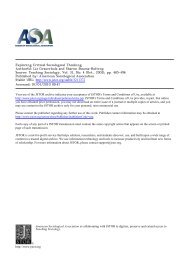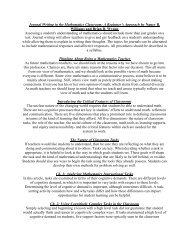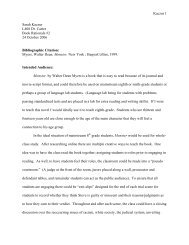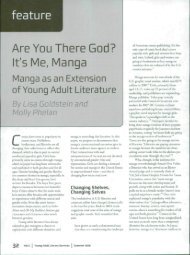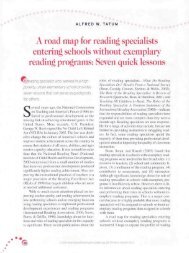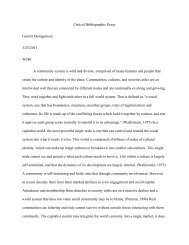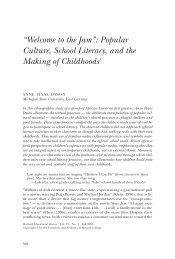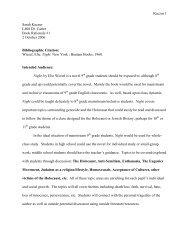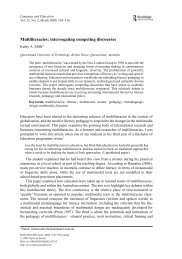McDonald 2004 Critical Reading 10-11 year olds.pdf - Oncourse
McDonald 2004 Critical Reading 10-11 year olds.pdf - Oncourse
McDonald 2004 Critical Reading 10-11 year olds.pdf - Oncourse
You also want an ePaper? Increase the reach of your titles
YUMPU automatically turns print PDFs into web optimized ePapers that Google loves.
Literacy April <strong>2004</strong> 21<br />
<strong>10</strong>4S<br />
128S<br />
130S<br />
yourself for something you either didn’t want to<br />
do or felt uncomfortable about or . . . you felt<br />
that you couldn’t tell the truth. You had to make<br />
up an excuse. . . . Anybody want to talk about<br />
when they did something like that?<br />
Well, one day I was at Corey’s house and I was<br />
sick and her dad got really angry and he was<br />
calling me sook for being sick and so a few weeks<br />
later, Corey asked me to stay the night and I said<br />
Oh sorry we’re going out.<br />
When Jim was here . . . I slept over at his place<br />
twice and the first time Kieran his friend lived<br />
like two roads across, he kept asking if he could<br />
come over in front of everyone, and we said that<br />
we were going out, and once he came over and we<br />
were there. And we had to say we were just<br />
leaving.<br />
One time I went out to my auntie’s and she said<br />
something bad about my mother and then I went<br />
home. A couple of weeks later she asked me to go<br />
up there again and I said no I’m going away.<br />
(Lesson 7)<br />
In this excerpt the teacher did not take up the<br />
possibility of an analytical reading. Instead the<br />
relationship of the character’s life to human experiences<br />
was foregrounded as the students were encouraged<br />
to position themselves in similar ways to Susie,<br />
this time through their personal stories. Here the<br />
role of the students’ stories moved beyond establishing<br />
repertoire for the events of the novel: the stories<br />
themselves became integral to the making of<br />
inferences, the reasoning about the character’s motivations.<br />
A critical pedagogy: orienting students<br />
towards analytical talk<br />
One way ‘critical’ talk was introduced was through<br />
particular attention to specific gender perspectives<br />
presented in the novel. The characterisation of the<br />
novel’s three female generations permitted class<br />
discussion about alternative possibilities available to<br />
women of different ages. In these lessons the characters<br />
were ‘appraised’ in the light of how they lived their<br />
lives in the novel. Segments from two lessons, Lessons<br />
<strong>11</strong> and 15, will be discussed to demonstrate this focus.<br />
Appraising characterisation from a<br />
‘difference’ perspective<br />
The teacher encouraged appraisal by framing the<br />
classroom talk with a question which asked the<br />
students to consider ‘‘what makes the women in this<br />
story different . . . from typical female characters . . .<br />
that you have encountered’’ (Lesson <strong>11</strong>). The teacher’s<br />
question offered a subject position of critic: the<br />
students may situate themselves as analysts of<br />
characterisation, from a perspective which recognises<br />
that characters are ‘constructed’ by authors, rather<br />
than as responders to characterisation, from a perspective<br />
which perceives characters’ activities and<br />
qualities as representations of life.<br />
The students’ responses indicated their attempts to<br />
take up the position of analysts who can make<br />
generalisations about ‘typical’ female characterisation.<br />
They did this in several ways, as can be seen in the brief<br />
examples following, taken from different points in the<br />
talk:<br />
85S<br />
126S<br />
143S<br />
147S<br />
Sometimes – like she [Susie] hates people, other<br />
characters like people<br />
Usually the main character in the book – they are<br />
not as quiet – more open<br />
It is a writing technique<br />
She gets away – some other books are not very<br />
detailed. The girls normally just take one second<br />
in the shop but in this book it’s like a big thing,<br />
going to the shops (Lesson <strong>11</strong>)<br />
The teacher’s question had reframed the alreadyestablished<br />
qualities of some of the novel’s characters<br />
as atypical qualities of fictional female characters.<br />
Some student responses constructed a ‘typical’ characterisation<br />
as simply the opposite of the character’s<br />
known qualities (for example, 85S, while others drew<br />
on the verisimilitude of realistic fiction as in 126S). Two<br />
other students, however, perceived a deliberate construction<br />
of the ‘difference’ perspective: one student<br />
named it ‘a writing technique’ (143S) and a second<br />
student elaborated on this with a recognition of how<br />
the novel privileges female preoccupations. In the<br />
comment ‘‘in this book, it’s like a big thing, going to the<br />
shops’’ (147S) the student noted the narrative space<br />
and detail given to ‘going shopping’ and observed how<br />
‘other’ books do not chronicle this kind of event. These<br />
two students’ comments appear to recognise how<br />
‘different’ characterisation of females must be deliberately<br />
constructed as an alternative to ‘typical’ female<br />
mainstream characterisation, that is, ‘different’ (gendered)<br />
characters are constructed through the ‘different’<br />
(gendered) events in which they participate.<br />
Contrasting gendered characterisation<br />
To differentiate between the ‘ways of being’ represented<br />
by the two elderly women in the novel, the<br />
mysterious ‘Blue Lady’ and Mrs Watson, the teacher<br />
used contrasting language ‘balance-counterbalanceopposite-contrast’<br />
(1 T). A number of perspectives on<br />
elderly women were identified by the students in the<br />
classroom talk, as the excerpts below indicate.<br />
1T<br />
Which woman in the story is an interesting<br />
balance, counterbalance maybe would even be a<br />
better word, to describe the Blue Lady? Who<br />
would you name? . . . Who is the woman in the<br />
r UKLA 2003



